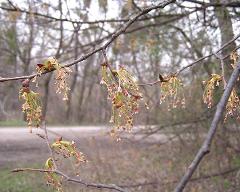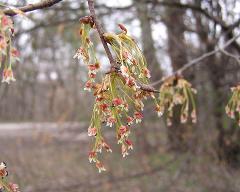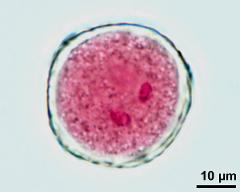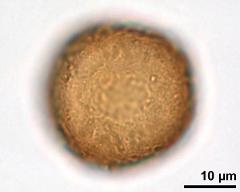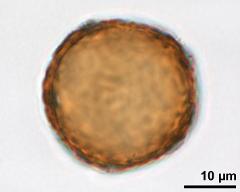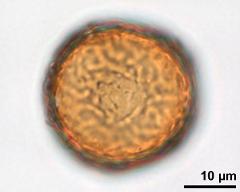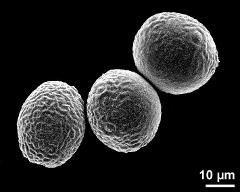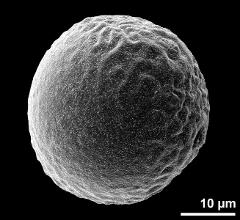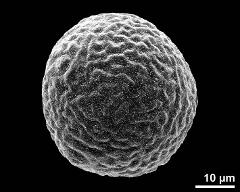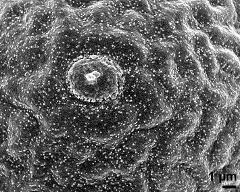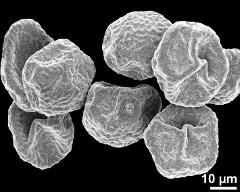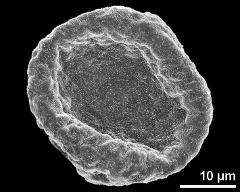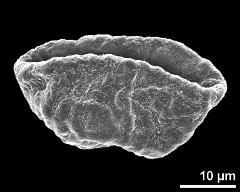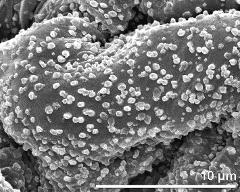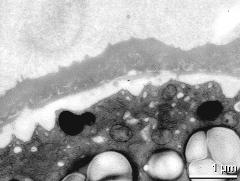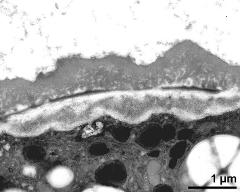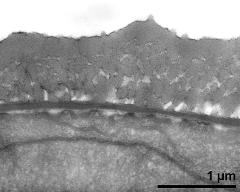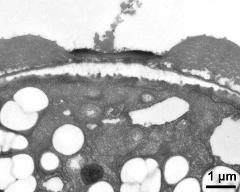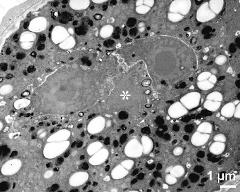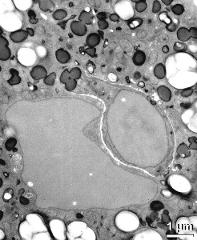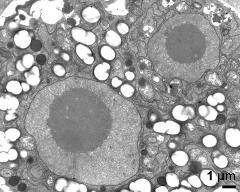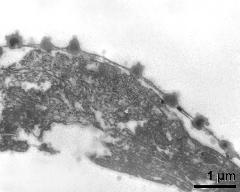Ulmus laevis
Taxonomy: Angiospermae, Rosales, Ulmaceae, Ulmus
Published: 2016-11-08
Pollen Description
Shape, Size and Aperture
pollen unit: monad, dispersal unit and peculiarities: monad, size (pollen unit): medium-sized (26-50 µm), size of hydrated pollen (LM): -, shortest polar axis in equatorial view (LM): -, longest polar axis in equatorial view (LM): -, shortest diameter in equatorial or polar view (LM): -, longest diameter in equatorial or polar view (LM): -, pollen class: porate, polarity: heteropolar, P/E-ratio: -, shape: spheroidal, outline in polar view: circular, dominant orientation (LM): -, P/E-ratio (dry pollen): -, shape (dry pollen): irregular, outline in polar view (dry pollen): irregular, infoldings (dry pollen): irregularly infolded, aperture number: 6, aperture type: porus, aperture condition: porate, aperture peculiarities: operculum
Ornamentation and Structure
LM ornamentation LM: rugulate, nexine: -, sexine: -, SEM ornamentation SEM: granulate, rugulate, suprasculpture SEM: -, TEM tectum: eutectate, infratectum: granular, foot layer: absent, endexine: compact-continuous, intine: monolayered, wall peculiarities: -, supratectal element: -
Miscellaneous
pollen coatings: absent, reserves in cytoplasm: starch, cell number: 3-celled, Ubisch bodies: present
Annotations: dry pollen irregularely infolded or cup-shaped; endexine not thickened in apertures; ornamentation rugulate to verrucate
Author(s) of diagnosis: Halbritter, Heidemarie; Diethart, Bernadette; Weber, Martina
Pictures
Picture legend
- flower(s), photographer: Diethart, B.
- flower(s), photographer: Diethart, B.
- pollen grain with two sperm cells - fresh, unfixed, aceto-carmine, photographer: Diethart, B.
- upper focus - fresh, acetolyzed, unstained, photographer: Diethart, B.
- optical section - fresh, acetolyzed, unstained, photographer: Diethart, B.
- lower focus - fresh, acetolyzed, unstained, photographer: Diethart, B.
- hydrated pollen grains - fresh, rehydrated (water) & critical point dried & sputter coated with gold, photographer: Halbritter, H.
- polar view - fresh, rehydrated (water) & critical point dried & sputter coated with gold, photographer: Halbritter, H.
- polar view; note differences in exine - fresh, rehydrated (water) & critical point dried & sputter coated with gold, photographer: Halbritter, H.
- aperture - fresh, rehydrated (water) & critical point dried & sputter coated with gold, photographer: Halbritter, H.
- dry pollen grains - dry, sputter coated with gold, photographer: Halbritter, H.
- polar view (dry pollen grain) - dry, sputter coated with gold, photographer: Diethart, B.
- dry pollen grain in equatorial view - dry, sputter coated with gold, photographer: Diethart, B.
- anther wall with Ubisch bodies - fresh, rehydrated (water) & critical point dried & sputter coated with gold, photographer: Diethart, B.
- interapertural area of pollen wall - fresh, glutaraldehyde & osmium & potassium ferrocyanide, modified Thiéry-test, photographer: Weber, M.
- interapertural area of pollen wall - fresh, glutaraldehyde & osmium & potassium ferrocyanide, uranyl acetate & lead citrate, photographer: Weber, M.
- interapertural area of pollen wall - fresh, glutaraldehyde & osmium & potassium ferrocyanide, uranyl acetate & lead citrate, photographer: Diethart, B.
- apertural area of pollen wall - fresh, glutaraldehyde & osmium & potassium ferrocyanide, uranyl acetate & lead citrate, photographer: Diethart, B.
- pollen grain at second pollen mitosis; vegetative nucleus (asterisk) - fresh, glutaraldehyde & osmium & potassium ferrocyanide, uranyl acetate & lead citrate, photographer: Weber, M.
- vegetative nucleus and sperm cell - fresh, glutaraldehyde & osmium & potassium ferrocyanide, modified Thiéry-test, photographer: Weber, M.
- vegetative nucleus - fresh, glutaraldehyde & osmium & potassium ferrocyanide, modified Thiéry-test, photographer: Diethart, B.
- Ubisch bodies on inner anther wall - fresh, glutaraldehyde & osmium & potassium ferrocyanide, modified Thiéry-test, photographer: Diethart, B.
Literature
- (1982) Apocynaceae, Bignoniaceae, Goodeniaceae, Lardizabalaceae, Menispermaceae, Nyctaginaceae, Papilionaceae, Rubiaceae, Samydaceae, Santalaceae, Sargentodoxaceae, Simaroubaceae, Thymelaeaceae, Ulmaceae. In: Angiosperm pollen flora of tropic and subtropic China. Inst Bot South China : 34-48, 60-65, 165-166, 183-186, 213-217, 244-246, 265-289, 305-325, 335-339, 351, 353-355, 375-377, 381-383
- (1986) Ontogenetic development of microspores of Ulmus (Ulmaceae). In: Blackmore S., Ferguson I.K. (eds) Pollen and spores: Form and Function. Acad Press, London : 19-33
- (1970) Species identification of Ulmus pollen. Dan Geol Unders 4: 1-19
- (1975) SEM studies on pollen grains of Northern European Ulmus species. Grana 14: 103-107
- (1989) Pollen morphology of Celtidaceae and Ulmaceae: a reinvestigation. In: Evolution, Systematics, and fossil History of the Hamamelidae. Vol 2: 'Higher'
- (1996) Phylogenetic analysis of Ulmaceae. Pl Syst Evol 200: 13-20
- (1994) Exkursionsflora von Österreich : 1180
- (1998) Preparing living pollen material for scanning electron microscopy using 2,2-dimethoxypropane (DMP) and criticalpoint drying. Biotechnic Histochem 73: 137–143
Copyright and Citation
Cite this publication as:
Halbritter H., Diethart B., Weber M. 2016. Ulmus laevis. In: PalDat - A palynological database. https://www.paldat.org/pub/Ulmus_laevis/302066;jsessionid=B987C5810E4096C668D8CF66E171796E; accessed 2025-11-01

